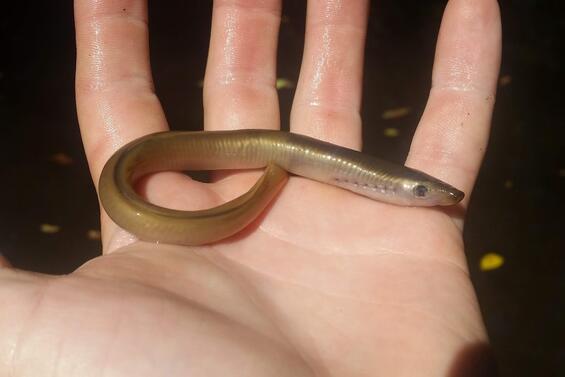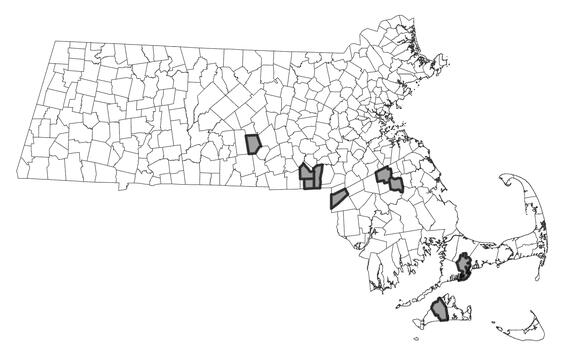- Scientific name: Lethenteron appendix
- Species of Greatest Conservation Need (MA State Wildlife Action Plan)
- Threatened (MA Endangered Species Act)
Description

American brook lamprey (Lethenteron appendix)
American brook lampreys are primitive eel-like fish that lack jaws, scales, paired fins, and bone. They have cartilaginous skeletons, one nostril between the eyes, seven pairs of pore-like gill openings, and seldom grow as large as 20 cm (8 in). Larval lampreys have eye spots that can only detect light and dark. As adults, they have true functioning eyes. Larval brook lampreys can be distinguished from larval seas lampreys by the lack of pigment on the lower half of the oral hood (fleshy hood around the mouth) and around the gills. After larvae metamorphose into adults, they have a circular mouth or oral disc with horny teeth and the eyes become prominent.
The only other lamprey species in Massachusetts is the sea lamprey (Petromyzon marinus). Sea lamprey larvae have pigment on much of the oral hood and around the gills. They can be difficult to distinguish as larvae. As adults, sea lampreys can reach up to 600 mm (~24 in), whereas the American brook lampreys only reach 200 mm (~8 in) in length.
Life cycle and behavior

American brook lampreys can live for four to six years. The first three to five years are spent as larvae, generally referred to as ammocoetes. At this stage, they live in burrows in sandy, mucky substrates and filter feed on benthic organic matter. They are blind, toothless, and have a fleshy hood around their mouth used for filter-feeding. When they reach a length of around 120 mm (~5 in), they begin to metamorphose at which point they stop feeding. This generally begins in the fall or winter and is completed by the spring spawning season. During this metamorphosis, lampreys change in a few key ways: 1) they become sexually mature; 2) their eyes become truly functional; and 3) their mouths change from filter-feeding mechanisms to round, suction disks with horny teeth called an oral disk.
American brook lampreys spawn from mid-April to early May. Males begin the construction of nests, creating a shallow depression in pea gravel substrates by moving rocks with their oral disk. Multiple individuals, both males and females, are often found in one nest and they all aid in nest construction after the initiation by the male. During copulation, females suck onto the bottom of the nest and the male attaches onto her head, both using their oral disks. As the sticky eggs are released, sand is kicked up, helping to cement the eggs in the nest. The adults die after spawning is completed. When ammocoetes hatch, they swim out of the gravel nest and drift downstream until the water flows slow down. Then they burrow into the stream bottom into soft substrates.
Distribution and abundance
The range of the American brook lamprey extends from Alabama and Georgia, west to Arkansas, north to Ontario, and east through the Great Lakes region, Atlantic slope, and New England. In New England the species has been recorded in every state. In Massachusetts, the species occurs in the French, Blackstone, Taunton, and Cape Cod watersheds including Martha’s Vineyard. However, the species is only currently known from 7 stream systems and typically occupies 1-2 stream segments, with about half of these streams with only a few individuals documented. The relatively viable populations occur in the Blackstone watershed.
American brook lamprey is listed as threatened in Massachusetts. As with all species listed in Massachusetts, individuals of the species are protected from take (collecting, killing, etc.) and sale under the Massachusetts Endangered Species Act.

Distribution in Massachusetts. 2000-2025. Based on records in the Natural Heritage Database.
Habitat
American brook lampreys live in cold to cool, small to medium-sized streams, typically of low gradient. Adults spawn in gravel substrates often found in riffle mesohabitats. Larvae inhabit mesohabitats with substrates consisting of fine to coarse sand, muck, and organic matter (e.g., backwaters or stream margins) located downstream of spawning areas.
Healthy habitats are vital for supporting native wildlife and plants. Explore habitats and learn about conservation and restoration in Massachusetts.
Low-gradient sandy stream suitable for American brook lamprey.
Threats
Habitat alteration is a major threat including increased erosion and sedimentation, flow alterations from impervious cover, channelization, water withdrawals, and climate change; increased water temperatures from climate change and loss in riparian forests; water quality degradation from industrial discharge, road salt runoff, and alteration of organic matter quality (primary food resource).
Survey and monitoring
American brook lamprey is monitored through routine fish community surveys, which are successful at detecting the species larvae in its riverine habitat. However, non-detections of this species do not equate to true absences and it’s possible the cryptic larvae inhabit more sites and streams than currently known.
Management
Management for this species focuses on habitat protection and restoration such as improvements to streamflow, dam removal, culvert replacement, and riparian and streambank restoration. Protection of forested riparian zones and watersheds is critical for maintaining high water quality and cooler water temperatures.
Research needs
Effort is needed to establish long-term monitoring sites to detect temporal trends in population size, develop a species distribution model to direct future survey efforts, targeted surveys in new and historical sites via conventional (e.g., electrofishing) and novel methods (e.g., eDNA) to maximize detection, determine spawning sites and refine spawning date range, determine potential seasonal migration behavior, identify potential dispersal barriers, determine population genetic structure and variation to determine gene flow, and assess the species risk to climate change impacts including increased stream temperature and extreme flows.
References
Aman, J.T., M.F. Docker, K.W. Grimes. 2017. New England range extension of American brook lamprey (Lethenteron appendix), as confirmed by genetic analysis. Northeastern Naturalist 24(4):536-543.
Beamish, F.W.H. and S. Lowartz. 1996. Larval habitat of American brook lamprey. Canadian Journal of Fisheries and Aquatic Sciences 53:693-700.
Evans, T.M., and A.M. Weber. 2020. Multiple stable isotopes identify sediment organic matter as the primary nutritional source to American brook lamprey larvae along a stream gradient. Canadian Journal of Fisheries and Aquatic Sciences 77:81-89.
Hartel, K.E., D.B. Halliwell, A.E. Launer. 2002. Inland fishes of Massachusetts. Massachusetts Audubon Society. Lincoln, MA.
Hartmann, J.H., M.A. Davis, J.S. Tiemann. 2024. Species distribution models predict suitable habitat for the overlooked and understudied freshwater lampreys of Illinois. Environmental Biology of Fishes:1-14.
Hoff, J. G. 1988. Some aspects of the ecology of the American brook lamprey, Lampetra appendix, in the Mashpee River, Cape Cod, Massachusetts. Canadian Field Naturalist. 102:735-737.
Mundahl, N.D., G. Sayeed, S. Taubel, C. Erickson, A. Zalatel, J. Cousins. 2006. Densities and habitat of American brook lamprey (Lampetra appendix) larvae in Minnesota. The American Midland Naturalist 156(1):11-22.
Contact
| Date published: | April 11, 2025 |
|---|